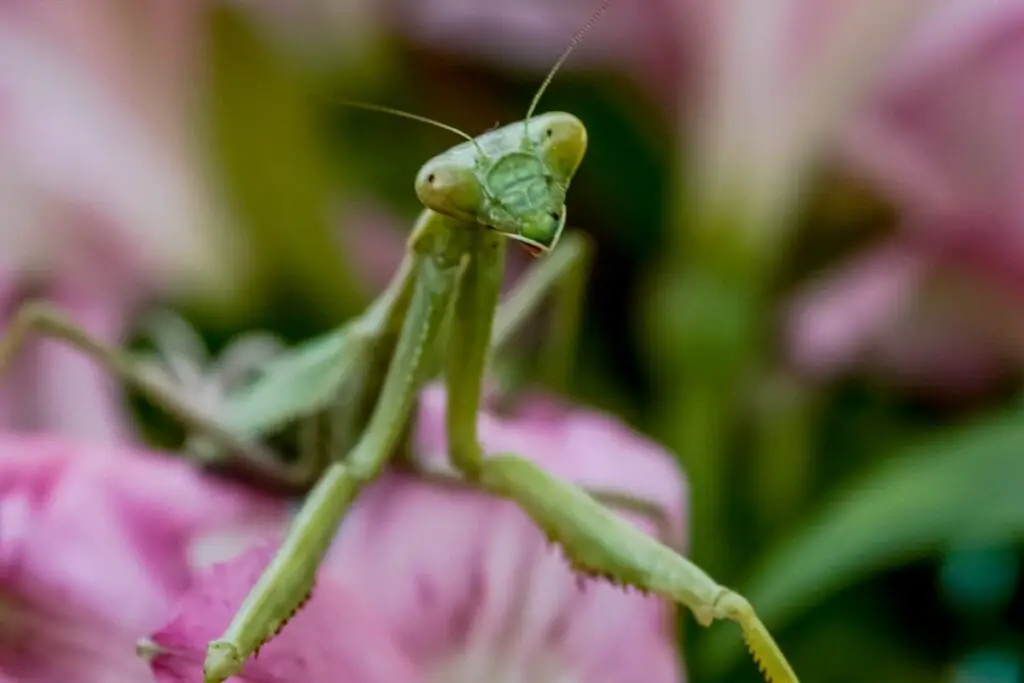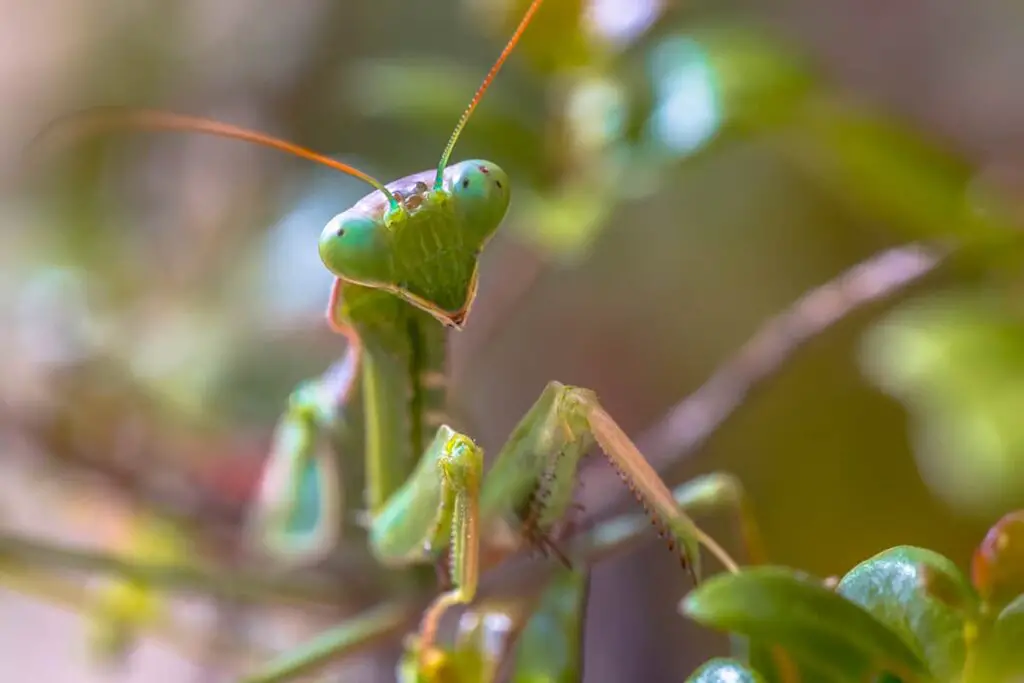Praying mantises are fascinating and beloved insects for their unique appearance and predatory habits. Keeping them as pets, you have a special opportunity to observe their behavior firsthand. But how do you ensure your mantis lives a full and healthy life in captivity? It’s all about the care you provide. Proper housing, diet, temperature, and humidity are pivotal in maximizing the lifespan of your praying mantis.
By mimicking their natural environment, you give your mantis the best chance to thrive. Proper cage size, for instance, offers them ample room to move and climb, which is essential for their well-being, much like their behavior in the wild where they climb in foliage. Catering to their dietary needs with a variety of live insects and creating a terrarium that facilitates easy molting are also key aspects of care.
Attention to the unique needs of your mantis species in terms of humidity and temperature can make a difference as well. Some mantises require a tropical setting, while others may prefer more temperate conditions. Understanding these details is crucial for a long and healthful life for your mantis, making your experience as a caretaker all the more rewarding.
Fundamentals of Mantis Care
Crafting the perfect environment for your praying mantis will lead to a healthier, longer-lived pet. By focusing on the optimal habitat and diligently managing temperature and humidity, you can maximize the well-being of your mantis.
Optimal Habitat
Your praying mantis thrives in an enclosure that mimics their natural environment. Substrates such as coconut coir or soil not only maintain humidity but also absorb moisture. It’s essential for the habitat to be vertically oriented as mantises like to climb and it must have adequate space for molting, which occurs several times during their life. Include foliage and branches for climbing and hiding. For smaller or nymph mantises, a tall jar or small aquarium can suffice, but larger species may require a terrarium for ample space.
Temperature and Humidity Control
A consistent temperature between 70°F and 85°F should be maintained to mirror a mantis’s natural, warm habitat. Temperature affects your mantis’s growth rate and lifespan—a proper balance prevents too rapid growth or prolonged development. Humidity should be kept between 40% and 70%, depending on the species. This can be achieved through daily misting. Monitoring with a reliable hygrometer will ensure your mantis’s environment stays within these critical parameters, thereby reducing the risk of health issues like mis-molting.
Nutrition and Feeding
Proper nutrition is essential for extending the lifespan of your mantis. Ensuring a balanced diet and regular feeding are key to your mantis’s health.
Feeding Schedule
Feed young mantids daily due to their rapid growth. Adults require feeding every 2-3 days. Overfeeding can shorten your mantis’s lifespan, so monitor their appetite and adjust feeding frequency accordingly.
Dietary Needs
Your mantis thrives on a diverse diet of live insects. Common choices include fruit flies for younglings and crickets or moths for adults. For an orchid mantis, size and color of the prey can be important to mimic their natural hunting in flowers.
Supplements
While not always necessary, supplements can benefit mantises. Occasionally dusting prey with a calcium supplement can support exoskeleton strength. Check the nutritional needs for your specific species to see if supplementation is advised.
Health and Longevity
When caring for a praying mantis, your primary goal is to provide an environment that maximizes health and longevity. Ensuring that common health issues are prevented and addressed, along with proper preventative care, can lead to a thriving life for your mantis. If health issues arise, knowing when to seek veterinary support is crucial.
Common Health Issues
- Dehydration: It’s essential to maintain the right humidity levels, as mantises can easily become dehydrated. Signs include lethargy and lack of appetite.
- Molting Problems: Inappropriate humidity or nutrition can lead to failed molts, a serious health issue for mantises.
- Parasites and Infections: Parasites like mites or fungal infections can affect your mantis’s health. Keep an eye out for any unusual marks or behavior.
Preventative Care
- Habitat: Ensure that the terrarium is the appropriate size with suitable climbing and hanging surfaces, as detailed in the care guide for Theopropus Elegans.
- Diet: Feed your mantis a varied diet of suitable live insects, which is essential for its overall well-being.
- Temperature and Humidity: Tailor the habitat conditions including temperature and humidity to your mantis species’ needs, as they differ depending on the species.
Veterinary Support
- When to Seek Help: If you notice signs of distress or illness that you cannot address, consult a vet specialised in invertebrates.
- Regular Checkups: Although not common, regular check-ups with a specialized vet can help prevent some health issues from becoming serious.
Frequently Asked Questions
Caring for your pet mantis requires specific conditions to ensure its health and longevity. Here’s what you need to know to extend its life and maintain a healthy environment.
How can I extend the lifespan of my pet mantis in captivity?
To extend your pet mantis’s lifespan, provide a consistent and appropriate habitat, a balanced diet, and regular monitoring to prevent stress and diseases. Captive mantises can live much longer than their wild counterparts with proper care.
What are the ideal temperature and humidity levels for mantis care?
Mantises thrive in conditions that mimic their natural habitats. Temperatures should be maintained around 70°F to 85°F during the day, with humidity levels between 40%-70% depending on the species. Nighttime temperatures should not fall below 70°F.
What should I feed my praying mantis to keep it healthy and prolong its life?
Your praying mantis should be fed a variety of live insects, including flies, crickets, and moths. An appropriate diet for the species and size of your mantis is crucial to ensure proper nutrition.
How much and how often should I spray the habitat of my mantis?
Spray the mantis habitat lightly with water every 1-2 days to maintain adequate humidity levels and enable your mantis to molt properly. However, avoid oversaturating the environment as this can lead to health issues.
What are common signs of health issues in pet mantises to watch out for?
Be vigilant for signs such as lack of appetite, lethargy, discoloration, or trouble molting. These could indicate potential health problems that may need attention to prevent impacting your mantis’s lifespan.
How can habitat conditions impact the lifespan of different mantis species like the Chinese or Giant African mantis?
Different species, such as the Chinese or Giant African mantis, have specific habitat needs. The right temperature, humidity, and space are essential for their longevity and health. Incorrect conditions can cause stress and health complications.
Driven by a passion for those tiny creatures that rule our world, we at Bug Domain strive to be your go-to resource for information on insects.




